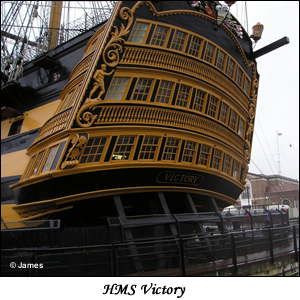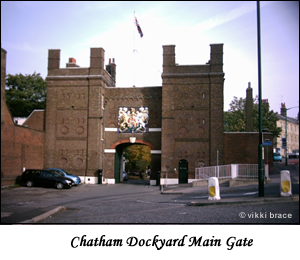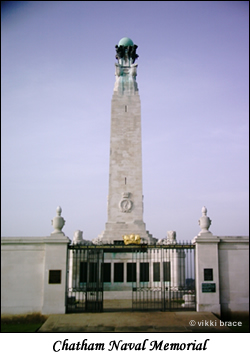Chatham is situated on the River Medway in Kent and has connections to the Royal Navy going back to the 16th century.
It was a small village until 1568, when it was established as a Royal Dockyard by Queen Elizabeth I, due to it’s strategic location, as the political situation worsened with mainland Europe.
At first, it was used as a refitting base but soon became a shipyard. Over the centuries it built over 500 ships for the Royal Navy, including ‘HMS Victory’, Nelson’s flagship at the Battle of Trafalgar, which was launched from Chatham Dockyard in 1765.

Daniel Defoe visited the dockyard in 1705 and wrote:
So great is the order and application there, that a first-rate vessel of war of 106 guns, ordered to be commissioned by Sir Cloudesley Shovell, was ready in three days. At the time the order was given the vessel was entirely unrigged; yet the masts were raised, sails bent, anchors and cables on board, in that time.
The dockyard needed fortifications to defend it from enemy attack and therefore Upnor Castle was built in the years leading up to its establishment. However it was to prove ineffective, as in June 1667, the Dutch attacked Chatham during the Second Anglo-Dutch War, destroying 13 ships and towing away two, one of which was the flagship of the English fleet, the ‘Royal Charles’.
The forts of Gillingham and Cookham Wood were subsequently built in 1669. The Chatham (or Cumberland) Lines fortifications, including Fort Amherst were built in 1756, with more forts completed during the Napoleonic Wars, including Fort Pitt, which was later used as a hospital and was the site of the first Army Medical School.

All of these forts required soldiers to man them and army barracks were subsequently built. Kitchener Barracks and the Royal Marine Barracks were built in the late 18th century, with Brompton Artillery Barracks and Melville Barracks constructed in the early 19th century. ‘HMS Collingwood’ and ‘HMS Pembroke’ were both naval barracks.
The dockyard itself expanded in the early 1600s, moving downstream to its present position, with two new mast ponds, docks, storehouses, and brick and lime kilns. Over the next century, further expansion took place, so that by 1770 the dockyard included a mile long gun wharf, four large docks and four slipways.
As the dockyard grew, so did the village of Chatham, as housing was built for the increasing workforce.

During the mid to late 19th century there was a huge building programme at the dockyard, including new basins and dry docks, as well as more fortifications. It required 110 million bricks, which regenerated the North Kent brick and cement industries, although much of the work was done by convict labour. In this period, the dockyard was producing on average, two ships a year, with it’s first ‘ironclad’ warship ‘HMS Achilles’ built in 1863.
In its heyday the dockyard employed over 10,000 skilled workers including shipwrights, carpenters, wheelwrights, smiths, joiners, sawyers, sail makers, riggers, pump makers, caulkers, rope makers, capstan makers, and coak and treenail makers. Charles Dickens’ father, John, worked as a naval pay clerk at the cashiers office of the dockyard between 1817 and 1822, when Charles was a small child.
The dockyard started to build submarines in the decade preceding the First World War, with the first, the ‘C17’, launched in 1908. Chatham was the principal manning port of the Royal Navy during the war. The construction and refitting of submarines continued throughout the inter-war years, during WW2, until the mid 1960s. The last was the ‘Okanagan’, which was built for the Royal Canadian Navy in 1966.
The Chatham Naval Memorial commemorates over 18,000 sailors of the Royal Navy who were killed during both world wars, who have no known grave.
A nuclear submarine refitting complex was built at the dockyard in 1968, however it was closed by the Government in 1984.
After the closure the dockyard was split into three parts. The easternmost basin was taken over by the Medway Ports Authority and is now operated as a commercial port. The 18th century core was transferred to the charitable Chatham Historic Dockayrd Trust and is open as a visitor attraction, with the 19th century ‘HMS Gannet’, the WW2 ‘HMS Cavalier’ and the 1960s submarine ‘HMS Ocelot’ on display, as well as a rope factory and a recreation of the dockyard from the 18th century. The remainder is used for commercial, residential and leisure purposes. St Mary’s island, which locals believe was used as a burial ground for the French POWs who died on the prison hulks moored on the Medway during the Napoleonic Wars, is now used for housing.
Velma Dinkley
© Velma Dinkley 2008
